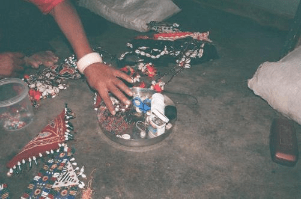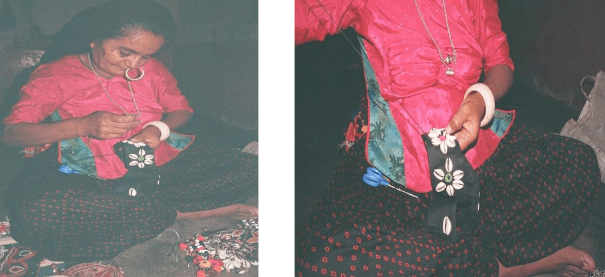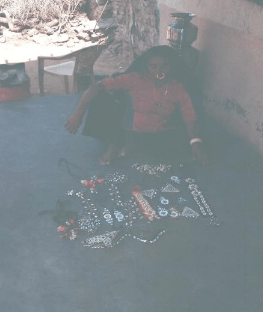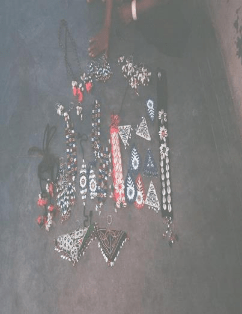Beadwork has been used as a symbol to denote wealth, love and status; as currency to bribe and barter; to ensure health and luck and to ward off evil spirits. Beads have been treasured and collected, all waiting to be used as something.
Beadwork, also called moti bharat, is believed to be later in origin than embroidery. Several patterns and motifs in Beadwork find close parallels in older embroidery.
Beadwork is as diverse in style as the many different groups that produce it. Though beads have been made since ancient times, the construction of beadwork, especially that using draw glass beads is comparatively recent. While Beadwork flourishes in some parts, its traditional use as ornament and dress has all but vanished amongst some of the minor tribal groups.
History
Gujarat is well known for the variety of skilled craftwork produced by its many different communities. Seed beads were imported into this region in the late 19thcentury. At that time professional embroiderers of the Mochi caste produced Beadwork. By the beginning of the 20thcentury, women of the Kathi landowning class were producing Beadwork as a home craft, in place of embroidery. Beadwork came to be adopted and copied by other caste groups, some of which were employed by the Kathi landlords. Beadwork in the Kathi style invariably has a white background, with beads of clear primary colored glass in motifs of peacocks, deities, elephants and flowers.
Regions
•Gujarat
•Rajasthan
•Nagaland
•Arunachal Pradesh
•Orissa
Each region has its own special way of doing beadwork using different techniques. This document is based on the craft carried out in the region of Gujarat.
Producer Communities
In Gujarat, moti bharat was traditionally done by Meghwals, Ahirs and Rabaris. Embroidery and beadwork are often used together in a particular pattern. The women of the Meghwal leather working caste continue to produce beadwork for their own use, making decorative chokers. In recent years beadwork has been used increasingly to decorate traditional Meghwal blouses. A Meghwal bridegroom covers his face with a mask of many strands of beads and small white shells, or beads of similar shape and size in place of the shells, suspended from an embroidered strip across the forehead. The Ahir pastoralists also use seed bead fringes to decorate household items. Like different embroidery styles, Beadwork is no longer confined to its original communities and regions.
Raw Materials
Earlier only glass beads were used. Now because of unavailability and high cost of glass beads, plastic beads are being widely used. Even though Bead work is produced extensively nowadays, the beads used are often uneven in size, and of plastic rather than glass. Ideally, the size of beads for any given pattern must be uniform, so the teach figure receives its correct definition of form and the motifs accommodate themselves comfortably in relation to each other. Paradoxically, the raw materials for the craft –the beads -are machine made and costly, while the spirit of expression is folk.
Nylon thread is used these days to string the beads. Cowrie shells are also used along with plastic and glass beads.
Availability
Beads are made in two regions:
Papanaiduped in Andhra Pradesh
Varanasi, Ferozabad and Purdalpur in Uttar Pradesh
They are easily available round the year.
Tools
The craftsperson requires a needle, thread and beads to start work!
Making of the craft
Complex patterns can be created just using beads and thread. Each bead is strung on a thread and meticulously placed according to the pattern on the surface of the fabric. Usually two methods are used to decorate the fabric, one is called the mono bead system and the other is called tri-bead system. In the mono bead system one row of beads is knitted with another row and so on like a picture. Colored beads are used on white back-ground. In the tri bead system, a net like effect is achieved. The technique in knitting is somewhat akin to cross-stitch in embroidery.
To create good quality beadwork it is important to choose the beads carefully. The size should be uniform; the quality of beads should also be good. Each bead is just an element in the larger pattern and the overall design creates the impact, rather than the individual beads. The artistry and skill lies in the design construction and execution of the article. In Beadwork very small and usually uniformly colored beads are transformed into intricate articles of embellishment. Older pieces have large and complex motifs -a testament to the skill of the worker, since this particular method of construction is one of the most difficult to use when depicting a figurative object. Many pieces are worked in such a way that the network of beads is attached to the backing fabric as it is made, while others are made more conventionally as a separate fabric of beads, which is then attached to supporting fabric
Products and their uses
Beadwork along with embroidery is used on garments, soft furnishings and bags. Patches are made with just beadwork on them; these patches can be sewn on a kurta or even a bag. Key chains, brooches, bajuband, belts, bags, torans and parandis are other products that are sold in the local market as well as in exhibitions.
Primary Market
Demand for Beadwork increases during the festival season in Gujarat, especially during Navratri time. In metros people prefer embroidery to beadwork. Most craftspeople have shifted to doing embroidery and using beads to further decorate the product. Some of these products (mostly beadwork-patch bags) are also exported to the United States and Japan.







